This report details the butterflies observed on a trip made to Farm Lator in Hungary from 8th July to 15th July 2006. The 10 members of the party were a varied bunch, some most interested in butterflies, some in moths, some in birds, and some in anything that moved! The "10" were Andy Collins, Chris Manley, Dave Green, Jennifer Chainey, John Chainey, Nick Montegriffo, Paul Butter, Peter Davey, Peter Eeles and Tim Norriss.
This was my first trip of this kind - dedicated solely to the pursuit of nature. A magical time where various phenomena were observed, including hill-topping, mud-puddling and beer-drinking (the first two will be explained later in this report!).
It should be noted that this report is fairly one-dimensional in that it focuses only on the butterflies observed on the trip. However, it would be a discredit to our hosts at Farm Lator to not at least mention the 400+ species of moth (we moth-trapped each night), 145 species of bird and numerous other species that we also saw, including the Lesser Horseshoe Bats (Rhinolophus hipposideros) that we saw in a specially-arranged visit to a nearby colony in the basement of a house over the road from Farm Lator.
An early start was required in order to make the 0750 flight from Heathrow to Budapest. We arrived on schedule and emerged from Budapest airport into the glorious sunshine that was to stay with us for the remainder of the trip. We were met by our driver from Farm Lator, our hosts for the trip. As soon as the bus started moving, we saw a Scarce Swallowtail (Iphiclides podalirius) fly by, which was to prove a good omen for our stay.
The trip was centred around the Bnkk Hills in the north east of the country, with excursions planned to Aggtelek National Park and Little Hortobagy. After 90 minutes we arrived at Farm Lator, which is nestled in the Bnkk Hills. The surrounding countryside, pace of life and lack of cars, immediately transported us to a place that had long-since disappeared from the UK. We were greeted by our hosts, Rob and Barbara de Jong, and sat down for refreshments. Rob was to act as our guide for the trip and a second guide, Szabolcs Safian (referred to as simply "Safi") was to join us the following morning.
Not long after arriving at Farm Lator, the first "Wow!" moment occurred; 2 High Brown Fritillary (Argynnis adippe) were spotted on the buddleia in the garden. For us Brits, who would normally have to travel some distance to see this species, this was quite something! I'm sure our hosts thought we were nuts! Anyway, this resulted in several of us walking around the fairly-extensive grounds to see what else was about. Within a couple of minutes we'd notched up Map (Araschnia levana f. prorsa), Heath Fritillary (Melitaea athalia) and a fleeting glimpse of a single Camberwell Beauty (Nymphalis antiopa), which turned out to be a "first" for the garden.
 |
| High Brown Fritillary (Argynnis adippe) feeding on Buddleia Image © Peter Eeles |
After we'd settled into our rooms and refreshed ourselves, we took a walk in the immediate vicinity of Farm Lator, including a wooded hillside, roadside verges and a grass-covered slope. Several Silver-washed Fritillary (Argynnis paphia) were seen feeding on the moisture and salts from nearby stone walls. The entire area seemed to be alive with wildlife!
 |
| Watching Silver-washed Fritillary (Argynnis paphia) near Farm Lator Image © Dave Green |
The area around Farm Lator resulted in an impressive sightings list, the highlights of which were Chestnut Heath (Coenonympha glycerion), Dark Green Fritillary (Argynnis aglaja), Great Banded Grayling (Brintesia circe), Large Copper (Lycaena dispar), Lesser Marbled Fritillary (Brenthis ino), Lesser Spotted Fritillary (Melitaea trivia), Purple Hairstreak (Neozephyrus quercus), Scarce Copper (Lycaena virgaureae), Short-tailed Blue (Everes argiades), Silver-washed Fritillary (Argynnis paphia), Weaver's Fritillary (Clossiana dia), White Admiral (Limenitis camilla) and Wood White (Leptidea sinapis). A Lesser Purple Emperor (Apatura ilia) was also watched as it flew around the treetops.
 |
| Short-tailed Blue (Everes argiades) Image © Peter Eeles |
So, without venturing more than 500 metres from Farm Lator, we'd already notched up 32 species in the space of a couple of hours. This trip was going to be good!
Day Listing
In this report, first sightings are shaded green in each table. Also, the letters O, L and P refer to Ovum, Larva and Pupa, respectively.
 |
Today was the first "serious" day where we made an excursion beyond the confines of Farm Lator. Today we visited two sites; the first being an area within the Bnkk National Park where the local villagers were holding some festive celebrations (of course, our eyes were firmly on the Lepidoptera!) and the second a site next to a large lake that was known for its population of the scarce Pallas's Fritillary (Argynnis laodice). The first site had 3 main habitats; a grass-covered slope, a wooded area, and a grass-covered hill that we were to ascend. Even the first of these was quite exciting, with good numbers of Eastern Pale Clouded Yellow (Colias erate), Silver-studded Blue (Plebeius argus) and Spotted Fritillary (Melitaea didyma).
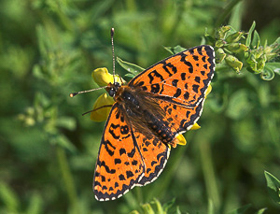 |  |
| Spotted Fritillary (Melitaea didyma) Image © Peter Eeles | Spotted Fritillary (Melitaea didyma) Image © Peter Eeles |
At the top of the slope, Rob found several Maculinea ligurica, which has no common name, and was formerly considered to be a subspecies of the Large Blue (Maculinia arion).
 |
| Maculinea ligurica Image © Peter Eeles |
A little further on, both Sloe Hairstreak (Satyrium acaciae) and Blue-spot Hairstreak (Satyrium spini) were found in good numbers nectaring on the agrimony. As if this weren't enough, I think all members of the party were absolutely shocked by the numbers of Heath Fritillary (Melitaea athalia). There were just too many to count; literally hundreds, making this one of the commonest species of the entire trip.
 |
| Blue-spot Hairstreak (Satyrium spini) Image © Peter Eeles |
With the larger numbers of individuals, another phenomenon arose; the more-frequent occurrence of aberrations. As we moved through the wooded area, members of our party found aberrations of both Ringlet (Aphantopus hyperantus) and Heath Fritillary (Melitaea athalia).
 |  |
| Ringlet (Aphantopus hyperantus) ab. lanceolata Image © Peter Eeles | Heath Fritillary (Melitaea athalia) ab. cymathoe Image © Peter Eeles |
Rob also found a mating pair of Assmann's Fritillary (Melitaea britomartis), which is extremely difficult to tell apart from Heath Fritillary (Melitaea athalia). Rob gave us a lengthy explanation of the subtle differences, producing a couple of handouts that proved that these were, without doubt, a new species for us!
 | 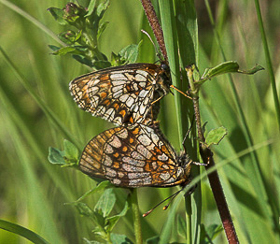 |
| Assmann's Fritillary (Melitaea britomartis) Image © Dave Green | Assmann's Fritillary (Melitaea britomartis) Image © Peter Eeles |
As we continued through the wooded area, with many clearings, we came across several new species for the trip, including Pearly Heath (Coenonympha arcania).
 |
| Pearly Heath (Coenonympha arcania) Image © Peter Eeles |
At the other side of the wooded area we could see the slope that we were to ascend in front of us. But not before we examined the flower-rich areas at the base of the slope. This area, again, proved fruitful. Here we notched up yet more new species, including Twin-spot Fritillary (Brenthis hecate), Weaver's Fritillary (Clossiana dia), Lesser Spotted Fritillary (Melitaea trivia) and Woodland Grayling (Hipparchia fagi).
 |
| Weaver's Fritillary (Clossiana dia) Image © Peter Eeles |
The hill we then walked up proved to be equally-fruitful. On the ascent we observed Safflower Skipper (Pyrgus carthami), Wood White (Leptidea sinapis), Green-underside Blue (Glaucopsyche alexis) and one of my favourites for the day, since it represented an extremely-rare migrant to the UK, the Queen of Spain Fritillary (Issoria lathonia). This was another "first" for me!
 |
| Queen of Spain Fritillary (Issoria lathonia) Image © Peter Eeles |
The slope was also frequented by good numbers of Great Banded Grayling (Brintesia circe) and Woodland Grayling (Hipparchia fagi).
 |
| Great Banded Grayling (Brintesia circe) Image © Peter Eeles |
In addition, we encountered several examples of the leucomelas form of the Marbled White (Melanargia galathea) where the female has reduced hindwing markings.
 |
| Marbled White (Melanargia galathea) f. leucomela Image © Peter Eeles |
At the top of the hill we encountered yet more new species! In particular, we were party to the phenomenon known as "hill-topping", where butterflies congregate at the highest point in order to find a mate. At the top we found good numbers of both Swallowtail (Papilio machaon) and Scarce Swallowtail (Iphiclides podalirius).
 |
| Swallowtail (Papilio machaon) Image © Peter Eeles |
Other highlights seen at the top of the hill were Eastern Baton Blue (Pseudophilotes vicrama), Hungarian Glider (Neptis rivularis) and some very fresh Wall (Lasiommata megera). This site finished with us seeing a total of 47 species!
We then moved onto the Pallas's Fritillary site. The site itself is next to a large lake, and we had to make our way through a wooded path that was absolutely infested with mosquitoes! However, the Fire-bellied Toads (Bombina bombina) found in just about every puddle made up for the inconvenience! No sooner had we emerged from the wooded area, when a Pallas's Fritillary (Argynnis laodice) was spotted nectaring on a nearby plant. Absolutely incredible, since they're pretty hard to locate! A 30-minute walk around the area revealed another half-a-dozen Pallas's Fritillary.
 |
| Pallas's Fritillary (Argynnis laodice) Image © Peter Eeles |
Back at Farm Lator, a larva of the Southern Festoon (Zerynthia polyxena) was found feeding in the grounds, marking the end to another superb day.
 |
| Southern Festoon (Zerynthia polyxena) larva Image © Peter Eeles |
Day Listing
Site A - Bnkk National Park
Site B - Bnkk National Park - Pallas's site
Site C - Farm Lator
 |
Today was to turn out to be equally-amazing. Not only were we to see our main target for the day, the Alcon Blue (Maculinea alcon), but we were also to find a new species for one of the sites visited. The day started with a trip to an area within the Bnkk National Park known for Alcon Blue (Maculinea alcon). On leaving the bus, we were immediately confronted with a Lesser Purple Emperor (Apatura ilia) on the ground, and several Scarce Copper (Lycaena virgaureae) flying around a meadow. The coppers were also nectaring on a small privet bush.
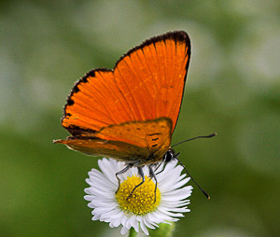 |  |  |
| Scarce Copper (Lycaena virgaureae), Male Image © Peter Eeles | Scarce Copper (Lycaena virgaureae), Female Image © Peter Eeles | Scarce Copper (Lycaena virgaureae), Underside Image © Peter Eeles |
There was so much activity that it took us some time to get to the Alcon Blues just 200 metres away! Another distraction was a pool of water that was attracting many different whites and fritillaries.
However, we eventually made it to a meadow containing fairly long grass, which is where we found the Alcon Blue (Maculinea alcon). They had clearly been out for some time, since the females were ovipositing on cross-leaved gentian (Gentiana cruciata), with over 30 eggs counted on some plants.
 |  |
| Alcon Blue (Maculinea alcon), Underside Image © Peter Eeles | Alcon Blue (Maculinea alcon), ovipositing Image © Peter Eeles |
On the way back to the van several Large Tortoiseshell (Nymphalis polychloros) were seen feeding from the small pools of water that filled the pot holes in the road where the van was parked.
 |
| Large Tortoiseshell (Nymphalis polychloros) Image © Peter Eeles |
We then set off to Nagy-Mezo, deep within the Bnkk National Park. On the way we stopped at some lime kilns in the hope of potentially finding some Nettle Tree (Libythea celtis) butterflies. Unfortunately, it was not to be. However, finding a single Wood White (Leptidea sinapis) and a Spotted Fritillary (Melitaea didyma) pupa made up for this. Finding a Fire Salamander (Salamandra salamandra) also added to the excitement!
 |
| Spotted Fritillary (Melitaea didyma) pupa Image © Peter Eeles |
The entrance to Nagy-Mezo was via a manned barrier that typified most entrances into this National Park. Entrance was possible via the presentation of appropriate papers. leaving the bus, a short walk through a wooded area, where White Admiral (Limenitis camilla) were seen, led us to a most-amazing spectacle, with large open areas of flower-rich grassland awaiting us.
 |
| Horses roaming free at Nagy-Mezo Image © Dave Green |
This was an amazing site, with 3 species of copper seen; Purple-edged Copper (Lycaena hippothoe), Purple-shot Copper (Lycaena alciphron) and Scarce Copper (Lycaena virgaureae). But the highlight was seen in a fairly central area around a clump of bushes, where the Geranium Argus (Aricia eumedon), a new species for this site, was found, including a very obliging mating pair.
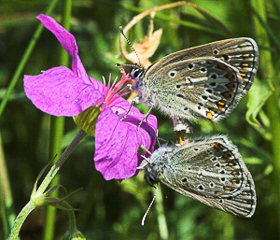 |
| Geranium Argus (Aricia eumedon), Mating pair Image © Peter Eeles |
"Colias!" was shouted on several occasions. Once you realise that this is "Clouded Yellow species" then you're ok! On this point, the observation was made that it is always preferable to use the scientific (latin) names when referring to species when abroad, since our own vernacular names are sometimes meaningless. So, "Colias" it was.
Just as we were exiting the site, one of the local wardens turned up who apparently felt that we'd provided the incorrect papers at the entrance gate. After a lengthy debate we were on our way.
Day Listing
Site A - Farm Lator
Site B - Bnkk National Park - Alcon Blue site
Site C - Bnkk Hills - Lime Kiln
Site D - Nagy-Mezo
 |
Today we spent a couple of hours travelling from Farm Lator to Aggtelek National Park; a trip well-worthwhile as we were to see an amazing 50 species at one site. The Park itself contains many different types of habitats including open grassland, rocky outcrops and woodland, with each habitat offering up different species.
 |
| Aggtelek National Park Image © Dave Green |
The first highlight of the day was seeing Nickerl's Fritillary (Melitaea aurelia) as we entered the site, this being another fritillary that, like Assmann's Fritillary (Melitaea britomartis), is very difficult to tell apart from the Heath Fritillary (Melitaea athalia)- which is where our guides came in very handy!
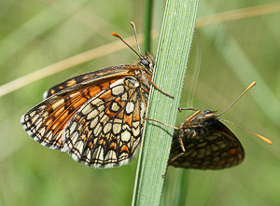 |
| Nickerl's Fritillary (Melitaea aurelia) Image © Dave Green |
This area was also very good for hairstreaks (and blues in general), with sightings of Blue-spot Hairstreak (Satyrium spini), Green Hairstreak (Callophrys rubi), Ilex Hairstreak (Satyrium ilicis) and Sloe Hairstreak (Satyrium acaciae). We also found many skippers, especially Safflower Skipper (Pyrgus carthami) and Large Grizzled Skipper (Pyrgus alveus) which both look very much like a large version of the Grizzled Skipper (Pyrgus malvae) found in the UK.
 |
| Safflower Skipper (Pyrgus carthami) Image © Peter Eeles |
After several hours, and another enjoyable day, we made our way to Josvafo and our lodgings for the night. As we sometimes travelled along single-track roads in dense woodland, we had visions that we would be staying in log cabins in a campsite. However, turning the last corner, we were confronted with a 5 star hotel nestled at the end of a valley! Time to wash up, eat, and rest for the day ahead.
 |
| Hotel in Josvafo Image © Dave Green |
 |
We made our way down to Josvafo village, where the local stream has stand pipes every hundred metres or so, supplying fresh water that, back home and bottled, would no doubt command a good price as natural spring water!
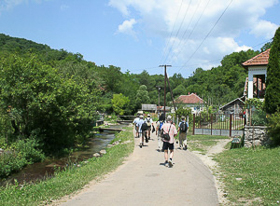 |
| Josvafo Village Image © Dave Green |
A short walk by the stream led us to one of the most-amazing sights I've ever encountered; a serious number of butterflies "mud-puddling". This is one of those moments that live with you forever. It's very difficult to describe, but to say that we saw literally hundreds of butterflies feeding, where species ranged from swallowtails to whites to skippers to blues to fritillaries to emperors, is no exaggeration. Another interesting phenomenon is that each family seemed to stay in its own group - although the whites and swallowtails liked to "mix it up" a bit. Perhaps the mud provides different quantities of salt in different areas that suits different species.
 |
| Mud-Puddling in Josvafo! Image © Rob de Jong |
Some of the better shots, we learned, are achieved by getting yourself level with the critters you're photographing. In the case of mud-puddlers, that means on the mud! One of our guides, Safi, showed us how it was done by laying on his front to photograph some swallowtails and clouded yellows.
 |
| Safi showing us how it's done Image © Dave Green |
What we didn't realise, before it was too late, is that this area of moisture was the outflow from the local farm. Suffice to say, we all needed a good shower as soon as possible! Yours truly is crouching down in the photo above, wondering where that smell is coming from!
 |  |
| Berger's Clouded Yellow (Colias alfacariensis) Image © Peter Eeles | Scarce Swallowtail (Iphiclides podalirius) and in-flight Eastern Short-tailed Blue (Everes decoloratus)! Image © Dave Green |
A short walk up a slight incline led us past a house that had a Lesser Purple Emperor (Apatura ilia) and Purple Emperor (Apatura iris) sunning themselves side-by-side. Unfortunately, a little too far away for a decent photograph! As we walked further into the woods, the numbers of Lesser Purple Emperor (Apatura ilia) increased, to the point that they were seen every 10 metres. I remember reading in Victorian literature how early Lepidopterists used to watch emperors flying in numbers by streams flowing through wooded areas. To experience this first-hand was just incredible!
 |
| Lesser Purple Emperor (Apatura ilia) Image © Peter Eeles |
An interesting aspect of the Lesser Purple Emperor (Apatura ilia) was that two forms were flying. The first produced the characteristic orange sheen of the male. This is a form known as clytie. However, the second form is lacking such an extreme sheen and, aside from the orange spot on the forewing, looks very much like a Purple Emperor (Apatura iris).
 |  |
| Lesser Purple Emperor (Apatura ilia) f. clytie Image © Peter Eeles | Lesser Purple Emperor (Apatura ilia) Image © Peter Eeles |
Walking further on we came to a more open area, with the odd Large Copper (Lycaena dispar) still flying, although rather late in the season for them.
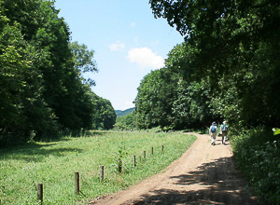 |
| Josvafo Woods Image © Dave Green |
A little way along the path, Lesser Purple Emperor (Apatura ilia) and Purple Emperor (Apatura iris) were seen feeding on the deposits from some horses. We also came across an interesting group containing Great Banded Grayling (Brintesia circe), Spotted Fritillary (Melitaea didyma) and Heath Fritillary (Melitaea athalia).
 |
| Great Banded Grayling (Brintesia circe), Spotted Fritillary (Melitaea didyma) and Heath Fritillary (Melitaea athalia)
Image © Dave Green |
We eventually came to an old shack that must have been used by the local woodmen at some point. This wreck of an abode clearly attracted the Nymphalids which were well-represented on its roof and walls, including Camberwell Beauty (Nymphalis antiopa), Lesser Purple Emperor (Apatura ilia), Purple Emperor (Apatura iris), Large Tortoiseshell (Nymphalis polychloros), Comma (Polygonia c-album) and Peacock (Inachis io).
A little further on we came to a more-open area that contained several Scarce Copper (Lycaena virgaureae) - all very fresh and making a wonderful sight as they flitted from flower to flower.
 |
| Josvafo Meadows Image © Dave Green |
We stopped off at a rocky outcrop before, exhausted from yet another full day, we headed back to Farm Lator for the perfect form of relaxation; beer and moth trapping!
Day Listing
Site A - Josvafo Stream
Site B - Josvafo Woods
Site C - Aggtelek Rocks
 |
Thursday was a very different day, where we headed to Borsodi-Mesozeg, also known as Little Hortobagy.
 |
| Borsodi-Mesozeg Image © Dave Green |
The primary attraction was the birdlife, seeing some spectacular species, such as Imperial Eagle (Aquila heliaca), Roller (Coracias garrulous) and Saker Falcon (Falco cherrug). However, there was still much for the Lepidopterist, with good numbers of Eastern Bath White (Pontia edusa) and Queen of Spain Fritillary (Issoria lathonia) being seen.
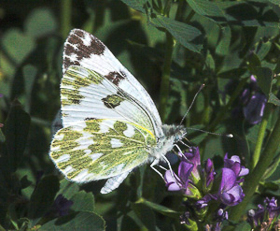 |
| Eastern Bath White (Pontia edusa) Image © Peter Eeles |
I'd told Safi on more than one occasion that a target species for me was Pale Clouded Yellow (Colias hyale); an extremely rare migrant to the UK. Safi pointed out a field full of clover nearby. He was sure we'd find some interesting Colias species there. Sure enough, the field was alive with Pale Clouded Yellow (Colias hyale) and many of the females were egg-laying right before my eyes. I was absolutely ecstatic that I'd finally, after many years, caught up with this particular rarity! We also achieved our first sighting of the Lesser Fiery Copper (Lycaena thersamon).
 |
| Pale Clouded Yellow (Colias hyale) Image © Peter Eeles |
The area we visited was lined with various irrigation ditches, which were an absolute magnet for dragonflies and Common Tree Frogs (Hyla arboria). Along a path next to one of these ditches we found a larval nest of the Knapweed Fritillary (Melitaea phoebe).
 |
| Knapweed Fritillary (Melitaea phoebe), larval nest Image © Peter Eeles |
Day Listing
 |
It was now nearing the end of a superb week, and there was little expectation on our hosts to provide yet more stunning sites. But more we were given.
The first part of the day was spent at Tajvedelmi. Our eagle-eyed hosts stopped the bus up a hill towards our destination where we jumped out to see our first Common Glider (Neptis sappho) of the trip. A relative of our White Admiral (Limenitis camilla), it behaved in a similar way, gliding (as its name suggests) between trees and eventually settling for the photographers!
 |
| Common Glider (Neptis sappho) Image © Peter Eeles |
When we eventually reached our destination, we got out of the van to be immediately greeted by a Pallas's Fritillary (Argynnis laodice) feeding on bramble. Several Lesser Purple Emperor (Apatura ilia) were seen on the ground near the van, and good numbers of fresh Map (Araschnia levana) butterfly.
 |  |
| Map (Araschnia levana) Image © Peter Eeles | Map (Araschnia levana) Image © Peter Eeles |
A group of Comma (Polygonia c-album) were also feeding from a small puddle. Another highlight awaited us a little further up the path, where 4 male Purple Emperor (Apatura iris) males were feeding together on some dung and intermittently flying around before settling again. Seeing so many emperors in one place was just breathtaking.
 |  |
| Purple Emperor (Apatura iris), 2 males Image © Peter Eeles | Purple Emperor (Apatura iris) Image © Peter Eeles |
Along the same path, several fresh Common Glider (Neptis sappho) were also seen, again offering good photographic opportunities.
 |
| Tajvedelmi Image © Dave Green |
We eventually came to a clearing where several Pallas's Fritillary (Argynnis laodice) were flying, although difficult to photograph. But a mating pair of Pale Clouded Yellow (Colias hyale) in the same clearing more than made up for this. A couple of male Large Copper (Lycaena dispar) were also seen.
We then moved on to another site, Csernely, which promised us two yet-to-be-seen species; Anomalous Blue (Agrodiaetus admetus) and Osiris Blue (Cupido osiris).
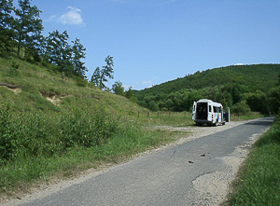 |
| Csernely Image © Dave Green |
The Anomalous Blue (Agrodiaetus admetus) is so-called because neither the male nor female are blue! Our hosts guided us to the exact area where we were likely to find them. And find them we did - including several mating pairs.
 |
| Anomalous Blue (Agrodiaetus admetus), mating pair Image © Peter Eeles |
We also found several Osiris Blue, which are very similar to our Small Blue (Cupido minimus). We also saw a number of Pallas's Fritillary (Argynnis laodice), and Marbled Fritillary (Brenthis daphne).
 |
| Marbled Fritillary (Brenthis daphne) Image © Peter Eeles |
This was another site where Camberwell Beauty (Nymphalis antiopa) were to be found, with one seen flying along the edge of a wood, and another seen on the ground as we were leaving. Unfortunately, neither of these sightings provided photographic opportunities, but the white fringe on the edge of the wings was quite unmistakable.
Day Listing
Site A - Tajvedelmi
Site B - Csernely
 |
Before heading for the airport, we had a couple of hours left to wander around Farm Lator and the surrounding area. Our total species count standing at 94. I decided to take one last wander up the hillside close to Farm Lator. On my way down the hill I saw what looked like a very large Ringlet (Aphantopus hyperantus) fly past me. On closer inspection, this turned out to be a newly-emerged Dryad (Minois dryas)! Our final count coming to 95 species for the trip, 5 short of the magical 100, but very respectable nonetheless!
 |
| Dryad (Minois dryad) Image © Peter Eeles |
Day Listing
 |
And so ended our week in Hungary. Packed with butterflies, and packed with memories. I'd like to thank our hosts, Rob and Barbara de Jong, and Safi, for the experience of a lifetime. I'd also like to thank my fellow-travellers, for putting up with a relative-novice; the crew included a Butterfly Conservation branch chairman, Natural History Museum entomologists, well-known experts in their field, book authors, and specialists in butterflies, moths, birds, and Ö pretty much anything that moved!
I, for one, will be returning!
For more information on Farm Lator, please visit their website at www.farmlator.hu where you'll be treated to more insights into this wonderful part of our planet!
Species on the British list are shaded in blue.
 |